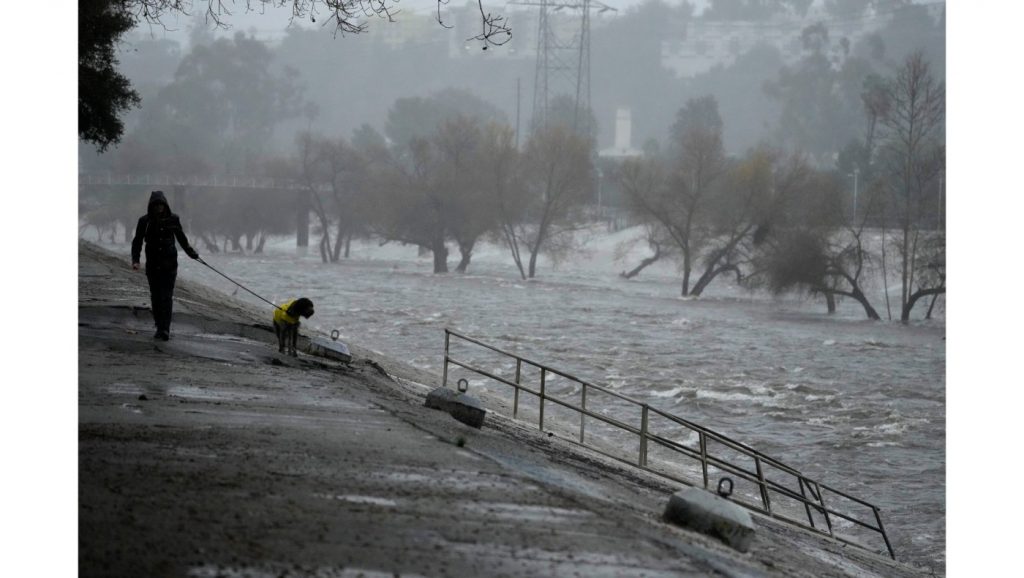Harris K. Telemacher was an L.A. TV weathercaster with a Ph.D. in humanities but no real meteorological training. So, assuming California weather was predictable, he taped his televised forecasts weeks in advance. This worked until an unexpected Pacific storm deluged the Southland during one of his pre-recorded forecasts.
Telemacher also was a fictional character invented by Steve Martin in the film “L.A. Story.” But he embodied a real-life cliché that needs retiring.
California weather has never been as predictable as a TV weathercaster gag — especially when it comes to the rain and snow of Golden State winters like this one.
In fact, no state in the lower 48 sees as much variability in its year-to-year precipitation as California. Such variability makes our weather as unpredictable as anything else in this volatile state. Last year, California was in the midst of the driest three-year run in recorded history when the National Oceanic and Atmospheric Administration forecasted a drier-than-average winter. Instead, we experienced one of our wettest winters ever.
Now, another winter of weather surprises has arrived, demonstrating that California desperately needs better seasonal forecasts so we can plan and protect ourselves in this era of climate change.
Seasonal forecasts are not the predictions of tomorrow’s weather delivered by Telemacher and his imitators. Seasonal forecasts provide ranges of possible climate changes for the next season on the calendar. Meteorologists will tell you that while it’s impossible to tell you the weather on a particular day months in advance, they should be able to predict how wet or dry the next season should be.
But that’s always been hard to do in California. Lately, it’s become even harder because of the state’s “weather whiplash” — the seesawing we’ve seen between flood and drought.
Our current inability to predict seasonal wet conditions makes it harder to manage water supplies (we must store more in wet winters to prepare for drier years), prepare for disasters (including unpredictable floods, like the one that just inundated San Diego), and maintain California agriculture, which supplies the nation’s food.
But improving seasonal forecasts is easier said than done. Even the most advanced meteorologists have failed to produce accurate seasonal forecasts. Indeed, recent studies suggest we need a better understanding of the peculiarities of the Pacific Ocean.
Determining how much rain or snow is likely to fall in California depends on predicting atmospheric patterns over the northern Pacific. To do so, meteorologists have closely monitored sea surface temperatures in the South Pacific and the phenomena known as El Niño and La Ninã. Warm temperatures, or El Niño conditions, were believed to herald rain. Cool La Niña conditions were thought to signal a dry winter.
But research from UCLA and the Jet Propulsion Laboratory finds that El Niño conditions don’t explain most of our weather variability. To cite one example, tropical sea surface temperatures and conditions were very similar in 2021-22 and 2022-23, but the first winter was dry and the second was one of our wettest.
Related Articles
Military names 5 Marines killed in helicopter crash in California mountains. All were in their 20s.
1 million Southern California homes have long-term flash flood risk
King tides swamp the California coast, gives glimpse at future sea level rise
More than 11,000 PG&E customers without power across Bay Area after punishing weekend storm
USMC confirmation: All 5 troops died in helicopter accident
According to the authors, to produce more accurate seasonal forecasts, scientists must know more about the ocean’s “circulation anomalies.” Current climate models, the paper argued, “show nearly no skill in predicting these” anomalies, which means they have “limited predictive skill for California winter precipitation.”
The paper also argued that current climate models can’t predict patterns that stem from tropical convection or the stratospheric polar vortex. This means that for better seasonal forecasts in California, meteorologists need a better understanding of conditions in the far-away western Pacific, Indian, and Arctic oceans.
How do we achieve this?
One answer is more detailed observation of oceans, sea ice and clouds. Another is to employ better computer capacity and artificial intelligence to build better climate models.
But such improvements won’t happen fast. So, for at least a few more winters, we’re stuck with unreliable seasonal forecasts and unpredictable weather.
Joe Mathews writes the Connecting California column for Zócalo Public Square.


